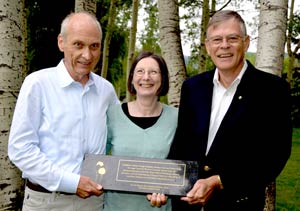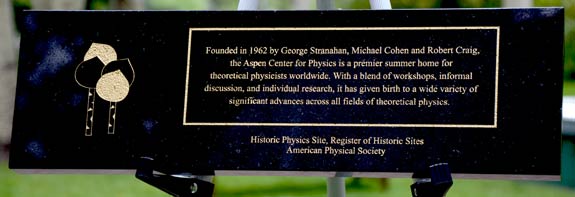Aspen Center for Physics
Aspen, Colorado
In 1961, physicists George Stranahan of the Carnegie Institute of Technology and Michael Cohen of the University of Pennsylvania approached the Aspen Institute in Aspen, Colorado with a proposal: create a unique research center where theoretical physicists might gather in the summer. Stranahan and Cohen envisioned an unstructured environment, free from distractions, where physicists could work unfettered by their normal responsibilities. The Institute's executive director, Bob Craig, was enthusiastic.
By the summer of 1962, the first Aspen Center for Physics (ACP) building, Stranahan Hall, provided offices for forty-five visiting physicists. Within a few years, the Center had gained a worldwide reputation as a unique environment for the pursuit of basic scientific knowledge. In 1968, it became an independent non-profit corporation, sharing seventy acres with the Aspen Institute and the Aspen Music Festival and School.
The Aspen Center for Physics has hosted many special groups, starting with the 1968 and 1969 studies that planned the experimental facilities for the National Accelerator Laboratory (now known as Fermilab). The 1969 studies of links between pulsar glitches and neutron-star superfluidity began at the Aspen Center for Physics and work on the physics of neutron stars flourished through the 1970s.
From the mid 1970s the Aspen Center for Physics nurtured a small cadre of pioneering string theorists, leading to the 1984 anomaly-cancellation paper that initiated the modern string revolution. The see-saw mechanism, which explains why neutrinos have such tiny masses, traces its origin to work done at the Center in 1978. Others studies included the 1970s astronomy decadal survey and several National Academy exchanges with the Soviet Union.
Since 1985, the Center has sponsored a series of winter conferences in forefront areas of physics. Other workshops in the 1980s and 1990s were critical in launching the field of particle astrophysics and cosmology and developing the current cosmological paradigm. In 1991, the archive (arXiv.org) was conceived at the Aspen Center for Physics, spurred by an unplanned conversation on the Center’s storied seminar patio, and in 1993, the phase diagram for the fractional quantum Hall effect was worked out during an Aspen Center for Physics workshop.
The Aspen Center currently runs a fifteen-week program of workshops, small working groups and individual research that attracts over 400 participants every summer, mostly theorists, both famous and novice, working in astro, condensed matter, particle, biological, and gravitational physics. Over the years, the Center has received funding from ONR, DOE, NASA, NIH, NSF, and the Sloan and other foundations, with its primary support coming from the National Science Foundation.
In addition to its research activities, the Aspen Center for Physics has a strong program of outreach including public lectures and dialogues, science activities for children and engagement with the Aspen public schools.
Note: The above information borrows freely from the History of Aspen Center for Physics. Any errors are ours.

In 1962, Aspen Center for Physics Stranahan Hall was ready, even if the road was not, to receive its first group of physicists.

With the Aspen Center commemorative plaque, Michael Turner, Chair, ACP Board of Trustees (left); Rosemary Wyse, President of ACP; and, Robert Byer, President of APS.

"Founded in 1962 by George Stranahan, Michael Cohen and Robert Craig, the Aspen Center for Physics is a premier summer home for theoretical physicists worldwide. With a blend of workshops, informal discussion, and individual research, it has given birth to a wide variety of significant advances across all fields of theoretical physics."
